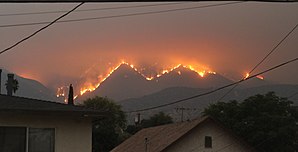تبدال د لمناخ
ف التخدام لعام لمصطلح ديال تبدال د لمناخ climate change كيوصف التسخان لعالمي global warming لي هوّ الطلوع د لموعدّال د لحرارة د لأرض، لي عبروه لعولاما، و بدا كيحس بيه بنادم د لقرن 21. التبدال د لمناخ ف معنى أعم كيتّقصد بيه التبدال لي طرا ف فترات قديمة د لأرض و على مدى زماني كبير. الزيادة لحالية ف لموعدال د لحرارة غادية ب زربة كبر من لفترات لي سبقو، و سبابو بشكل أساسي هوّ النشاطات د بنادم بحال لحريق ديال نواع لفيول بحال لپيطرول.[2][3] التخدام ديال لفيولات لفوصيلية fossil fuels، التقلاع د لغابات deforestation، و بعض لممارسات لفلاحية و الصناعية كاتساهم ف لڭازات د بيت لغرس greenhouse gases سيرتو تاني ؤكسيد لكاربون و لميطان.[4] لڭازات د بيت لغرس كايمتصّو السخونية من الشعا د الشمش لي كينعاكس على لأرض، و هادشي كيخلي لكوكب يبقى يسخن كلما تراكمو هاد لڭازات ف الجو.
التبدال د لمناخ عندو تأتير متزايد على لبيئة بحال التوساع ديال الصحاري و الزيادة ف عدد لحرايق د لغابات.[5] ف لمناطق لقطبية لمقدار ديال الجليد غادي و كينقص.[6] درجات لحرارة الطالعة كاتسبب ف عواصف قوية، جفاف، و شكال خرين ديال الطقس لحادّ.[7] التبدال ف لبيئة ديال الجبال، لمرجانات لبحرية، و لمناطق لقطبية كاتفرض على النواع لحية باش تهاجر ل مناطق جديدة ؤلا تنقارض.[8] وخا ينجح بنادم ف توقاف التبدال د لمناخ، لمفعول ديالو غادي يبقى ل قرون جايين، بحال السخونية د لمحيط، التحميض ديالو، و الطلوع د لمستوى د لبحر.[9]
التبدال د لمناخ كيهدد بنادم ب فيضانات، سخونية طالعة بزاف، قلة لماكلة و لما، لأمراض، و خسارات قتيصادية. لهجرة د بنادم و الصراعات على لموارد بحال لما تقدر تزاد بشكل كبر.[10] لمونضامة لعالمية د الصحة كاتعتابر التبدال د لمناخ أكبر خاطار على الصحة ف لعالم ف لقرن 21.[11] لمجتمعات لفقيرة هيّ أقل وحدة كاتساهم ف التبدال د لمناخ، و ف نفس لوقت أكتر وحدة معرّضة ل لمخاطير ديالو.[12][13]
- ^ Ivanova، Irina (June 2, 2022). "California is rationing water amid its worst drought in 1,200 years". CBS News.
- ^ IPCC SR15 Ch1 2018, p. 54: Since 1970 the global average temperature has been rising at a rate of 1.7 °C per century, compared to a long-term decline over the past 7,000 years at a baseline rate of 0.01 °C per century (NOAA, 2016; Marcott et al., 2013). These global-level rates of human-driven change far exceed the rates of change driven by geophysical or biosphere forces that have altered the Earth System trajectory in the past (e.g., Summerhayes, 2015; Foster et al., 2017); even abrupt geophysical events do not approach current rates of human-driven change.
- ^ Lynas، Mark؛ Houlton، Benjamin Z.؛ Perry، Simon (19 October 2021). "Greater than 99% consensus on human caused climate change in the peer-reviewed scientific literature". Environmental Research Letters. 16 (11): 114005. Bibcode:2021ERL....16k4005L. doi:10.1088/1748-9326/ac2966. Unknown parameter
|s2cid=ignored (معاونة) - ^ Our World in Data, 18 September 2020
- ^ IPCC SRCCL 2019, p. 7: Since the pre-industrial period, the land surface air temperature has risen nearly twice as much as the global average temperature (high confidence). Climate change... contributed to desertification and land degradation in many regions (high confidence).; IPCC SRCCL 2019, p. 45: Climate change is playing an increasing role in determining wildfire regimes alongside human activity (medium confidence), with future climate variability expected to enhance the risk and severity of wildfires in many biomes such as tropical rainforests (high confidence).
- ^ IPCC SROCC 2019, p. 16: Over the last decades, global warming has led to widespread shrinking of the cryosphere, with mass loss from ice sheets and glaciers (very high confidence), reductions in snow cover (high confidence) and Arctic sea ice extent and thickness (very high confidence), and increased permafrost temperature (very high confidence).
- ^ IPCC AR6 WG1 Ch11 2021, p. 1517
- ^ EPA (19 January 2017). "Climate Impacts on Ecosystems". مأرشيڤي من لأصل ف 27 January 2018. تطّالع عليه ب تاريخ 5 February 2019.
Mountain and arctic ecosystems and species are particularly sensitive to climate change... As ocean temperatures warm and the acidity of the ocean increases, bleaching and coral die-offs are likely to become more frequent.
- ^ IPCC SR15 Ch1 2018, p. 64: Sustained net zero anthropogenic emissions of موضيل:CO2 and declining net anthropogenic non-موضيل:CO2 radiative forcing over a multi-decade period would halt anthropogenic global warming over that period, although it would not halt sea level rise or many other aspects of climate system adjustment.
- ^ Cattaneo et al. 2019; IPCC AR6 WG2 2022, pp. 15, 53
- ^ IPCC AR5 SYR 2014, pp. 13–16; WHO, Nov 2015: "Climate change is the greatest threat to global health in the 21st century. Health professionals have a duty of care to current and future generations. You are on the front line in protecting people from climate impacts – from more heat-waves and other extreme weather events; from outbreaks of infectious diseases such as malaria, dengue and cholera; from the effects of malnutrition; as well as treating people who are affected by cancer, respiratory, cardiovascular and other non-communicable diseases caused by environmental pollution."
- ^ Tietjen، Bethany (2 November 2022). "Loss and damage: Who is responsible when climate change harms the world's poorest countries?". The Conversation. تطّالع عليه ب تاريخ 30 August 2023.
- ^ "Climate Change 2022: Impacts, Adaptation and Vulnerability". IPCC. 27 February 2022. تطّالع عليه ب تاريخ 30 August 2023.



![A dry lakebed in California, which is experiencing its worst megadrought in 1,200 years.[1]](http://upload.wikimedia.org/wikipedia/commons/thumb/d/d3/California_Drought_Dry_Lakebed_2009.jpg/129px-California_Drought_Dry_Lakebed_2009.jpg)